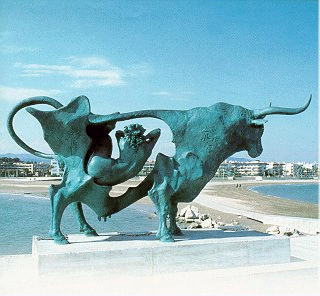
Minos was king of Crete, and the first ruler to control the Mediterranean Sea, which he ridded of pirates.. He had with him a famed craftsman, Daedalus the Athenian, who was in exile from Athens because he had murdered his nephew (and somewhat too talented apprentice), Talos. Daedalus enjoyed much favor at the court, but he managed to fall from grace by accommodating the queen, Pasiphaë, in a request.

Minos had boasted that the gods would grant him any wish; he made all the preparations for a sacrifice to Poseidon, then prayed that a bull would emerge from the sea. Miraculously, a beautiful white bull swam ashore. Minos admired it so much that he decided to keep it, and sacrificed a different one from his herd instead.
This unwise decision annoyed Poseidon, who avenged the insult by causing queen Pasiphaë to fall madly in love with the white bull. Her request to Daedalus was that he should help her consummate this passion. He did so by building an ingenious hollow wooden cow, covered with hide and with a door on top through which she could lower herself inside. Together, they wheeled it into the pasture where the bull was kept; Daedalus helped her get in, and then discreetly withdrew. Pasiphaë was completely satisfied ... (1)
And from that love was born the Minotaur. The Minotaur initiates, in this way, the myth of the birth of Europe, symbol of our Mediterranean Sea.
Pasiphae - Moon Goddess
In the web Lupercal (2) by John R. Mason, the author of "A Tale of spring" we found the relationship of Pasiphaë with the moon:
Daughter of Helios and Perseis. Sister of Circe. Married Minos. As
daughter of the sun she was a moon
goddess and as such was represented under the form of a white heifer.
The explanation of the Pasiphae myth ... is the ritual union of the moon
(Pasiphae as the white heifer) and the sun (the white bull).
From Robert Graves's The Greek Myths: 1 in the chapter Apollo's Nature and Deeds we have the comment:
His pursuit of Daphne the Mountain-Nymph, daughter of the river Peneius,
and priestess of Mother Earth, refers apparently to the Hellenic capture
of Tempe, where the goddess Daphoene ('bloody one') was worshipped by a
college of orgiastic laurel-chewing Maenads (see 46.2 and 51.2).
After suppressing the college - Plutarch's account suggests that the priestess
fled to Crete, where the Moon-goddess was called Pasiphaë (see
88.e) - Apollo took over the laurel which, afterwards, only the Pythoness
might chew. Daphoene will have been mare-headed at Tempe, as at Phigalia
(see 16.5); Leucippus (`white horse') was the sacred king of the local
horse cult, annually torn in pieces by the wild women, who bathed after
his murder to purify themselves, hot before (see 22.1 and 150.1).
From the Perseus Project site (4) Pausanias and Pseudo-Apollodorus about Pasiphae and the Moon.
Pausanias
Pausanias Description of Greece 3.26.1
[3.26.1] From Oetylus to Thalamae the road is about eighty stades long.
On it is a sanctuary of Ino and an oracle. They consult the oracle in sleep,
and the goddess reveals whatever they wish to learn, in dreams. Bronze
statues of Pasiphae and of Helios stand in the unroofed part of the sanctuary.
It was not possible to see the one within the temple clearly, owing to
the garlands, but they say this too is of bronze. Water, sweet to drink,
flows from a sacred spring. Pasiphae is a title of the Moon, and
is not a local goddess of the people of Thalamae.
Pseudo-Apollodorus
3,1,2,n6. Daughter of the Sun; compare Ap. Rhod., Argon. iii.999; Paus.
3.26.1, Paus. 5.25.9; Ant. Lib. 41; Mythographi Graeci, ed. Westermann,
Appendix Narrationum, p. 379; Ov. Met. 9.736. Pausanias interpreted
Pasiphae as the moon (Paus. 3.26.1), and this interpretation has been
adopted by some modern scholars.
The Cretan traditions concerning the marriage of Minos and Pasiphae
seem to point to a ritual marriage performed every eight years at Cnossus
by the king and queen as representatives respectively of the Sun and
Moon. See The Dying God, pp. 70ff.; A. B. Cook, Zeus, i.521ff. (who
holds that Europa was originally a Cretan Earth-goddess responsible for
the vegetation of the year).
Vilanova i la Geltrú, where its citizens are bewitched by the moon and where the coast is bathed by the same sea than bathes Creta, expresses recognition of Mediterranean civilization.
Sites in the WWW where the textxes were found.
(1) http://www.minotaur-websites.com/
(2) http://www.lupercal.u-net.com/main.html
(3) http://daphne.humgen.upenn.edu:1024/epodb/release/version_2.1/new_in_v2_1.html#daphne.bkd
(4) http://www.perseus.tufts.edu/
Photo from Vilanova i la Geltrú town council information brochure.